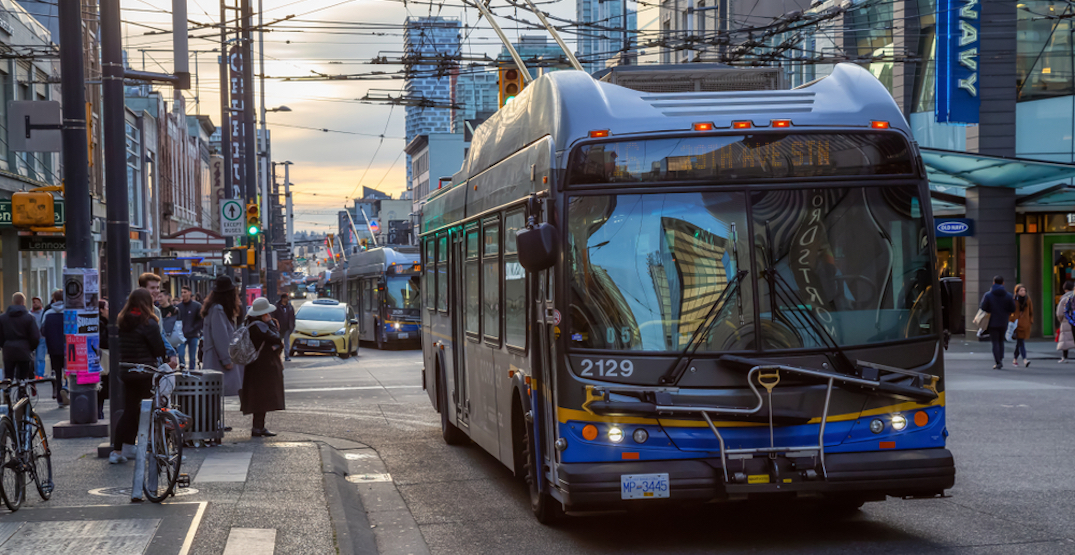TransLink to replace 188 trolley buses with new models in 2027

A new generation of electric trolley buses will be rolling onto the streets of Vancouver and western Burnaby starting later this decade.
In a report ahead of this week’s Mayors’ Council meeting, TransLink staff indicated that 188 electric trolley buses are aging and now reaching the end of their lifespan. These vehicles will be replaced with new models of trolleys in 2027.
Including the longer articulated trolleys, TransLink’s entire trolley bus fleet has 262 vehicles, making it one of the largest trolley fleets in North America.
- You might also like:
- TransLink launches ambitious strategy to reach net-zero emissions
- 100% of TransLink's entire bus fleet will be air conditioned by 2028
- TransLink to study transition to electric-battery ferries for SeaBus
- TransLink aiming to stop buying new diesel buses starting in 2023
- Federal government funds $16M for TransLink's first 100% electric-battery bus route
- Trolley bus fleet won't be replaced by electric-battery buses, says TransLink CEO
Instead of replacing the trolleys with electric-battery buses, TransLink is buying replacement trolleys to maximize its past investment in catenary infrastructure — 320 km of overhead trolley power lines, 10,700 trolley line poles, and 22 rectifier power supply stations. The trolley buses already achieve the same zero-emission intent as the electric-battery buses.
Phasing out the trolleys would also incur highly substantial costs of dismantling the very extensive catenary infrastructure, along with the associated significant costs of installing more charging infrastructure for electric-battery buses. The Vancouver Transit Centre bus depot — the storage and maintenance base for the entire trolley fleet, located at the north end of the Arthur Laing Bridge — would also have to be completely overhauled.

A TransLink trolley bus on Granville Street crossing Robson Street. (Shutterstock)

A look at TransLink’s Vancouver Transit Centre next to the Arthur Laing Bridge. (TransLink)
Several kilometres of catenary lines were recently installed along West 12th Avenue between Cambie Street and Arbutus Street, and along Macdonald Street between West 4th Avenue and West Broadway to provide West Broadway trolley bus routes with a temporary detour during the years-long construction process for SkyTrain’s Millennium Line Broadway Extension. These new trolley power lines will remain in place as a permanent fixture after the completion of the subway.
In early 2020, as part of the changes to accommodate the new R4 RapidBus service, after a years-long absence, trolley buses returned to 41st Avenue for the No. 41 Joyce Station/Crown route using retained trolley infrastructure.
The trolley network saw a large contraction in the 2000s; trolley infrastructure along Cambie Street was not reinstated after the completion of the Canada Line, with the No. 15 Cambie/Olympic Village route switched to diesel buses.
The 13 bus routes operated with trolleys are some of the busiest bus routes for ridership in Metro Vancouver.
The existing fleet of trolley buses arrived between 2005 and 2009 from Winnipeg-based manufacturer New Flyer, which replaced TransLink’s previous fleet of trolleys that had been in use since the early 1980s. The previous fleet was sold to a public transit authority in Mendoza, Argentina, which began using the vehicles in 2009 after refurbishment. By 2017, Mendoza fully discontinued the use of Vancouver’s former trolleys due to age and poor reliability and sent them to scrap.
Last week, TransLink unveiled an ambitious net-zero carbon strategy by 2050, with phased conversions of aging fossil-fuel powered buses to electric-battery models, renewable fuel sources for West Coast Express locomotives and existing SeaBus ferry vessels, new generation electric-battery SeaBus vessels, and green design overhauls to existing buildings and facilities.
The retainment of the trolley network is part of this broader strategy, which depends on significant capital funding from the federal and provincial governments.

A trolley bus in Beijing that also has long-distance electric-battery capability. (Kenneth Chan/Daily Hive)
- You might also like:
- TransLink launches ambitious strategy to reach net-zero emissions
- 100% of TransLink's entire bus fleet will be air conditioned by 2028
- TransLink to study transition to electric-battery ferries for SeaBus
- TransLink aiming to stop buying new diesel buses starting in 2023
- Federal government funds $16M for TransLink's first 100% electric-battery bus route
- Trolley bus fleet won't be replaced by electric-battery buses, says TransLink CEO

